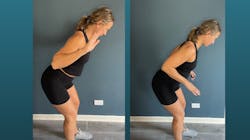Chronic pain from muscular imbalances: How to exercise correctly to avoid pain
Editor's note: This is part one of a series. Read part two here.
There’s an old saying of “no pain, no gain.” Whoever said this did not work in dentistry. In fact, it’s quite the opposite for dental professionals. Instead of gaining, they lose—productivity, days of work, comfort, and years in their career. All of this is lost due to chronic pain from their practices. Chronic pain is the result of a muscle imbalance, but it can be fixed and prevented through a specialized exercise program.
What is a muscle imbalance?
A muscle imbalance is when opposing muscle groups are not of the same size and strength. One muscle is short and tight from overuse and the opposing muscle is long and weak from underuse. In dentistry, a common imbalance comes from leaning over a patient. This causes an imbalance between the anterior muscles of the chest and the posterior muscles of the back. Over time this leads to poor posture, including a forward head and rounded shoulders. This is also known as upper-crossed syndrome.
What is upper-crossed syndrome?
Upper-crossed syndrome is a disorder where the muscles of the neck, chest, and upper back are short and tight—the neck flexors, pectorals, and the upper trapezius. To the contrary, the muscles of the back are long and weak—the mid and lower trapezius, rhomboids, and serratus anterior. This results not only in poor posture but leads to pain in the neck and shoulders, which worsens over time if not properly addressed.
Related articles
Proper "pandemic ergonomics" leads to better clinician and patient experiences
Establishing the ideal posture for your practice: Let’s put it in neutral
With the hope of alleviating their pain, many dental professionals regularly visit massage therapists, chiropractors, physical therapists, and acupuncturists. The problem is that all these providers fix the pain only temporarily. Therefore, regularly scheduled follow-up visits are required.
The reason for this is that muscles are like rubber bands. They can be stretched, and this will relieve tension temporarily, but muscles always revert to being tight unless the opposing, weak muscles are strengthened. The long-term solution for alleviating pain is through a specialized exercise program that strengthens the long, weak muscles.
Exercising for upper-crossed syndrome
When it comes to muscle imbalances, it is crucial to avoid certain exercises and incorporate others through strength training, also known as resistance training. Upper-crossed syndrome causes pectorals and upper trapezius muscles to tighten, so chest-focused exercises should be avoided. This includes pressing exercises such as bench press, chest press, and pushups. These exercises work the already tight muscles, so working the opposing muscles will help fix this imbalance and reduce pain. The muscles are already tight from overuse, so working the opposing muscles will help fix this imbalance and reduce pain.
Another reason to avoid these is because they are compound exercises, meaning they work multiple muscles at one time. In addition to working the pectorals, these exercises work the anterior deltoids, muscles that are extremely overworked by dental professionals.
More exercises to avoid are overhead shoulder presses and lateral raises. Like chest presses, these work the tight, overused muscles of dental professionals—the front and medial deltoids.
Exercises that should be included in programs for dental professionals are variations of both vertical pull (figure 1) and horizontal pull (figure 2), sometimes referred to as a row. These work the long and weak posterior muscles, including the middle and lower trapezius, rhomboids, and rear deltoids. While strengthening these muscles is a key component in correcting posture and alleviating pain, following a program that uses progressive overload is required to build strength in these muscles.
What is progressive overload?
Progressive overload is when the acute variables in an exercise program are adjusted over time. Examples of acute variables are repetitions, sets, weight, tempo, and rest time. This is adjusted to place additional stress on the muscles, which forces them to adapt to the increase in stimuli and work to become stronger. Without adjusting these variables, muscles will not gain size or strength; they will simply stay the same. In addition to progressive overload, it’s important for corrective exercises to be included in a program for dental professionals.
What are corrective exercises?
Corrective exercises address and fix movement compensations and muscular imbalances. Aside from standard strength or resistance training, the protocols are slightly different as they include a multistep process.
Take the following steps to fix an imbalance or faulty movement pattern.
First, the self-myofascial release must be performed on the overused muscles. This is followed by static stretching of the same overused muscles to lengthen them. Next, activation of the long and weak muscles is required to essentially “wake them up.” This is done through isolated strengthening exercises. Last, the final step is to integrate dynamic movements to retrain the body's movement patterns. This is to build the muscle strength of the long and weak muscles so they can become of equal strength to the short and tight muscles.
This exercise properly aligns the body to correct posture, reduce pain, and avoid injury. With dental professionals prone to muscular imbalances, it is 100% essential to implement corrective exercises.
Exercise to reduce pain and increase health
Dental professionals have some of the most physically demanding jobs, and this wreaks havoc on their bodies. It only makes sense that specialized exercises are required to combat the chronic pain that comes from poor posture and muscle imbalances. While patients need professional advice on proper oral health and home-care techniques, dental professionals need advice about proper exercise techniques. Just like a good oral health routine keeps teeth healthy, a good exercise routine keeps muscles healthy.
Editor's note: This article appeared in the September 2022 print edition of RDH magazine. Dental hygienists in North America are eligible for a complimentary print subscription. Sign up here.
About the Author

Brianne Novaes, CPT
Brianne Novaes, CPT, has been a certified personal trainer for 10-plus years and has worked with thousands of clients of all ages. She’s worked in multiple areas of fitness, including personal training, semiprivate training, group fitness, medical fitness, corporate wellness, and fitness center management. Her expertise is in strength training and building muscle to avoid pain and prevent injury. She also has knowledge in mobility, flexibility, and stability training. She is the founder of Built by Brianne, which provides specialized strength programs for dental professionals. Contact her at [email protected] or visit builtbybrianne.com.
